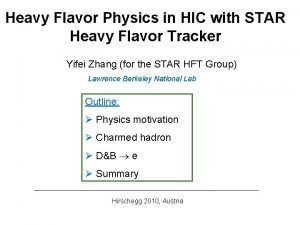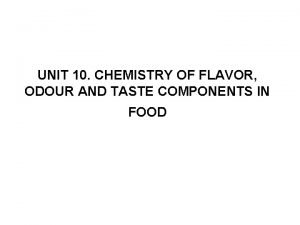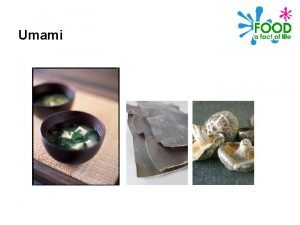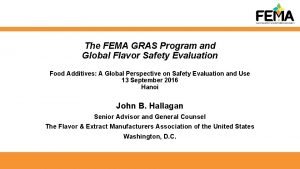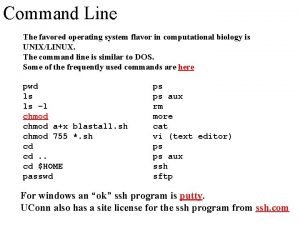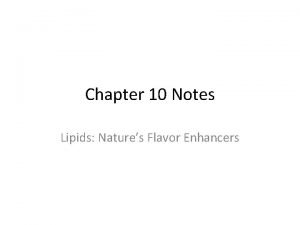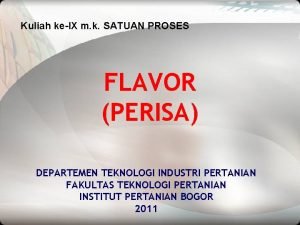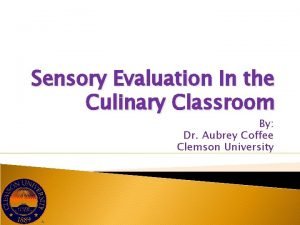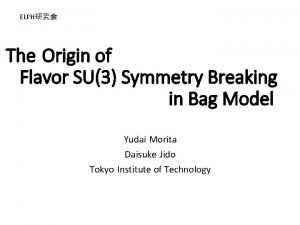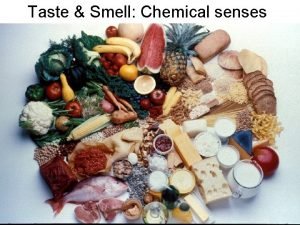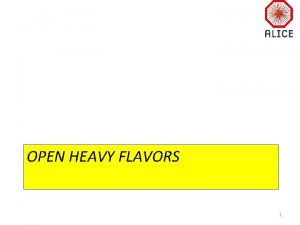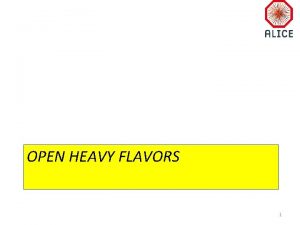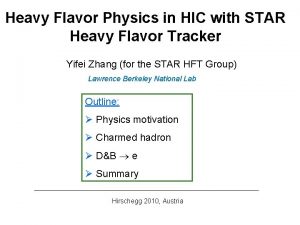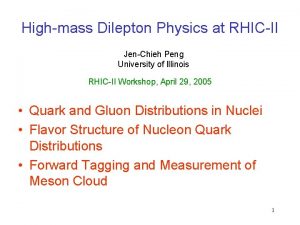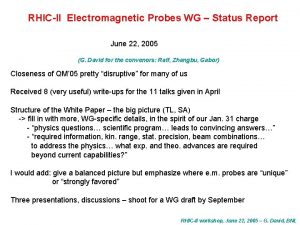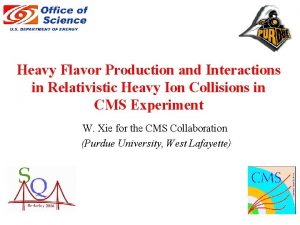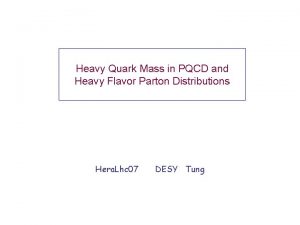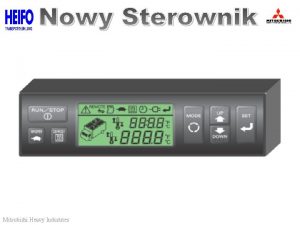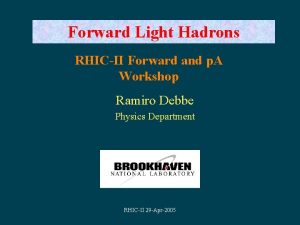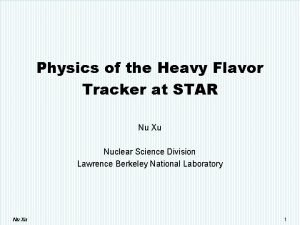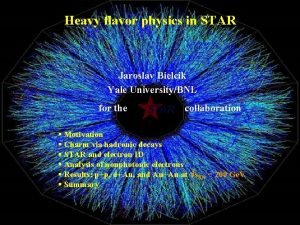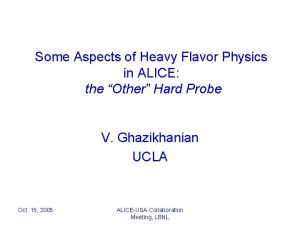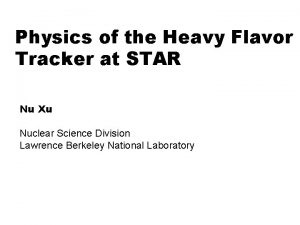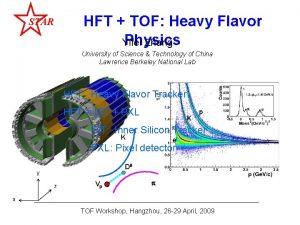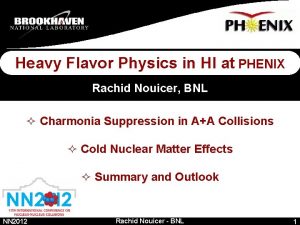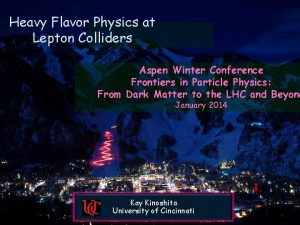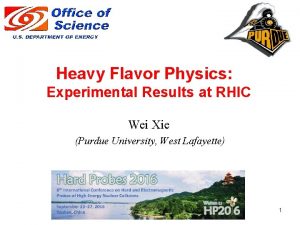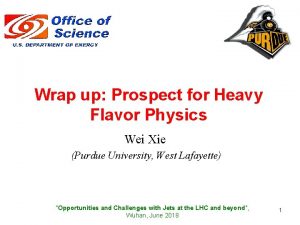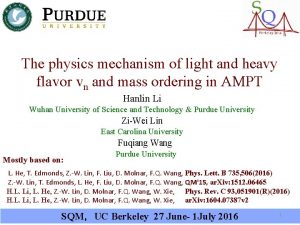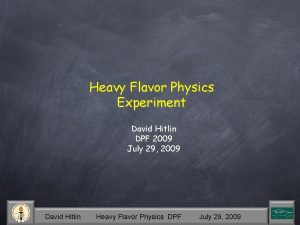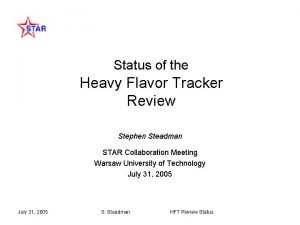A Case For RHICII Heavy Flavor Physics Status























- Slides: 23

A Case For RHIC-II: Heavy Flavor Physics Status Report of the RHIC-II Heavy Flavor Working Group Thomas Ullrich for the HF Group BNL Program Advisory Committee Meeting November 3, 2005 Heavy Flavor Group Conveners: T. Frawley, R. Vogt, TU Web site: http: //rhicii-science. bnl. gov/heavy/

Why Quarkonia? – What Can We Learn? Charmonia: J/y, Y’, cc u Bottomonia: (1 S), (2 S), (3 S) Key Idea: Melting in the plasma l l Color screening of static potential between heavy quarks: § J/y suppression: Matsui and Satz, Phys. Lett. B 178 (1986) 416 Suppression of states is determined by TC and their binding energy Ebinding (Ge. V) u J/y 0. 64 y’ 0. 05 cc 0. 2 (1 S) 1. 1 (2 S) 0. 54 (3 S) 0. 31 Sequential disappearance of states: Color screening Deconfinement QCD thermometer Properties of QGP 2

Quarkonia – Baseline Theory (pp/d. A) u Need properly “normalized” Quarkonia baseline l l u pp production baseline d+Au cold matter effects (absorption, shadowing) pp l l Color Evaporation Model (CEM) Quarkonium production treated as fraction of all QQ pairs below HH threshold CEM taken to NLO (Gavai et al. , G. Schuler and R. Vogt) Parameters adjusted to existing data Direct production ratio 0. 62 y’ 0. 14 cc 1 0. 60 cc 2 0. 99 (1 S) 0. 52 (2 S) 0. 33 (3 S) 0. 20 J/y + ’+ ’’ hep-ph/0412158 J/y 3

Quarkonia – Baseline Theory (pp/d. A) u p. A l l Nuclear Absorption § Breakup of quarkonia in the final state § Depends if produced as color singlet or octet Shadowing § Modification of PDFs in the nucleus w. r. t. free nucleon § NB: y-distributions more sensitive than p. T R. Vogt, RHIC-II Science Workshop 4

Quarkonia – Lattice QCD (AA) Singlet free energy: F 1 (entropy term? ) l Singlet energy: V 1 l u When do states really melt? Neither F 1 nor V 1 are potentials spectral functions (results consistent with V 1) J/y melts at 1. 5 -2. 5 TC l Tdiss(y’) Tdiss(cc)< Tdiss( (3 S)) < Tdiss(J/y) Tdiss( (2 S)) < Tdiss( (1 S)) l F. Karsch, RHIC-II Science Workshop Recent developments: u Heavy Quark potential? Collision with thermal gluons, p ~ 3 Tc can lead to earlier dissociation: d. NJ/y/dt = -Ng sdis 5

Quarkonia – Effects in AA u Feed down: Large from cc states (30 -40% ? ) l Not well measured in hadronic collisions l Unknown at RHIC energies l u Other sources of quarkonia production Statistical coalescense (thermal production) § too small at RHIC – larger at LHC ? l Dynamic coalescence § coalescence: c+c J/y § recombination: J/y c+c J/y § narrower y and softer p. T distributions l u u Quenching at high-p. T ( discussed later) Comover absorption l J/y + p (r) DD (negligible for ) Many effects that need to be understood to extract pure “suppression” mechanism 6

Open Heavy Flavor – What Can We Learn? Open Heavy Flavor Mesons: D 0, D*, D±, Ds, B u Key Idea: Study interaction with hot and dense media l l l u u u Yields Spectra Correlations High-p. T suppression Density of medium, E-Loss mechanism Low-p. T flow, spectra Thermalization ? Transport properties of the medium Charm-Charm, Charm-Hadron, J/y-Hadron Correlations: l l Low-p. T High-p. T Thermalization ? Tomography of medium Study of heavy flavor Properties of QGP (Density, Thermalization) 7

Open Heavy Flavor – Baseline Theory (pp) Heavy Quark production is a “hard” process perturbative QCD u Calculations on NLO (e. g. R. Vogt et al. hep-ph/0502203) depend on: Quark mass mc, mb l Factorization scale m. F (typically m. F = m. T or 2 m. T) l Renormalization scale m. R (typically m. R = m. F) l Parton density functions (PDF) l Fragmentation functions (FF) – plays important role l Fixed-Order plus Next-to-Leading-Log (FONLL) l designed to cure large logs for p. T >> mq where mass is not relevant M. Cacciari et al. , PRL 95: 122001, 2005 u 8

Open Heavy Flavor – Energy Loss in Medium path length L w k. T u l In vacuum, gluon radiation suppressed at q < m. Q/EQ l l u Various Models to describe E-loss in hot medium: BDMPS, GLV, … Gluon Radiation Probability “dead cone” effect implies lower energy loss (Dokshitzer-Kharzeev, ‘ 01) energy distribution w d. I/dw of radiated gluons suppressed by angle-dependent factor suppress high-w tail Collisional E-loss: Qg Qg, Qq l d. E/dx ln p - considered small (Armesto, Salgado, Wiedemann, PRD 69 (2004) 9

Open Heavy Flavor – Elliptic Flow u Observed large elliptic flow of light/s quark mesons at RHIC l u Strong evidence for thermalization What about charm? Naïve kinematical argument: need mq/T ~ 7 times more collisions to thermalize lv 2 of charm closely related to. Study R Van Hees & Rapp, PRC 034907: resonantinheavy-light Moore & Teeny: diffusion coefficient QGP, AA of 71, l u Examples: quark scattering viacoefficient), scalar, pseudoscalar, vector, model and axial D = T/Mh (h drag using a Langevin vector D-like-mesons 10

RHIC Results – Charm Cross Section u Study of D mesons (Kp combinations/event mixing) and non-photonic single electrons (from semileptonic D decays) l Cross section 2 -4 × larger than predictions from NLO H. Zhang, QM’ 05 u Issues: D mesons: large background l Non-photonic electrons: smeasured/scc ~ 15% l Need direct measurement of D mesons (via K p) 11

RHIC Results – Charm Energy Loss u Study of non-photonic single electrons (from semileptonic D decays) First evidence of strong suppression of charm at high-p. T l Challenge to existing E-loss paradigm (collisional E-loss important? ) l X. Dong, QM’ 05 u Issues: Statistics at high-p. T limited, uncertainties due to photonic background l Cannot deconvolute contributions from charm and bottom l Need direct measurement of high-p. T D mesons (via K p) and B mesons (via J/y) 12

RHIC Results – Charm Flow u Study of non-photonic single electrons (from semileptonic D decays) First hint of strong charm elliptic flow for p<2 Ge. V/c l Measurements from STAR & PHENIX deviate at higher p T l STAR: 30 -40% sys. errors u Issues: l l u Statistics limited Uncertainties due to photonic background Large sys errors Cannot deconvolute contributions from charm and bottom Need direct measurement of D mesons (via K p) v 2 X. Dong, QM’ 05 13

RHIC Results – J/y Suppression u Study of J/y ee and mm in Au+Au and Cu+Cu l l l u V. Ciancolo, PANIC’ 05 l Yield is suppressed compared to that in p+p collisions Suppression is larger for more central collisions. Suppression beyond that of cold nuclear matter for most central collisions even if sabs ~ 3 mb. Cold matter effects underpredict the suppression Issues: Lack of statistics l Only J/y measurement so far l Need more statistics and data on Y’, cc, and states 14

RHIC Results – J/y Suppression T. Gunji, PANIC’ 05 No recombination Recombination predicts narrow p. T and rapidity distribution: u p. T 2 vs. Ncollisions l Predictions of recombination model match better. u RAA vs. Rapidity l No significant change in rapidity shape compared to p+p result. Recombination compensates suppression? u Issues: l Charm rapidity distributions at RHIC are open questions l Require more data on √s, A dependence Need more statistics, J/y v 2 15

Quarkonia – RHIC-II Goals and Requirements Physics Motivation Probes Studies Requirements Baseline J/y, y’, (1 S), (2 S), (3 S) through mm and ee decay channels Rapidity y(x. F) and p. T spectra in AA, pp as a function of A, √s High luminosity and acceptance. High resolution to resolve states Deconfinement & Initial Temperature J/y, y’, (1 S), (2 S), (3 S) Melting patterns of quarkonia states Extract suppression mechanism taking into account: feed down, nuclear absorption, and recombination Properties of the medium High-p. T J/y RAA: Dissociation Quenching High luminosity Thermalization &Transport properties of the Medium J/y flow (v 2) as a function of A, √s Recombination: y and p. T 2 High luminosity to obtain good statistics in short time (A, √s scans) 16

Quarkonia – RHIC-II Goals and Requirements In order to extract the desired suppression signals the following measurements have to be achieved: Topic Studies Requirements Nuclear effects • shadowing • absorption Quarkonia in pp, p. A: • x 2, x. F dependence • A dependence • rapidity distributions over wide range Large y coverage Forward coverage to high x. F Suppression vs. Recombination • charm production ds/dp. Tdy • v 2 of J/y • p. T dependence of suppression High resolution vertex detectors Contribution from feed down Measure cc at least in pp and p. A Photon detection at mid and forward rapidity, high luminosity, good energy & momentum resolution to minimize background Quarkonium production p. A: cc / J/y A-dependence J/y polarization (? ) As above Large acceptance for cos q* 17

Open Heavy Flavor – RHIC-II Goals and Requirements Physics Motivation Probes Studies Requirements Baseline D/B mesons, nonphotonic electrons • Rapidity y(x. F) and p. T spectra in AA, p. A as a function of A, √s High Luminosity High resolution vertex detectors (ct(D) ~ 100300 mm) High-p. T PID (D Kp) Thermalization, Transport properties of the medium D mesons, B? non-photonic electrons (D+B) Elliptic flow v 2 p. T spectra as above Properties of the medium Initial conditions D, B (B J/y + X) mesons, nonphotonic electrons RAA(p. T), RCP of D , B as a function of p. T for various √s as above Properties of the medium Heavy Flavor Production D mesons, nonphotonic electrons Correlations: • charm-charm • charm-hadron • J/y-hadron HIGH luminosity (eff 2 !) Large coverage Trigger ? 18

RHIC-II - Facing the Challenge u Addressing the requirements: l l u STAR: l l l u RHIC-II: increased luminosity (RHIC-II ≈ 40 × RHIC) § Note: collision diamond s = 20 cm at RHIC and s = 10 cm at RHIC II gain in usable luminosity is larger than “nominal” increase PHENIX & STAR: more powerful upgraded detectors crucial to the Heavy Flavor physics program - completed in mid/near term ~5 years. DAQ upgrade increases rate to 1 KHz, triggered data has ~ 0 dead time. Silicon tracking upgrade for heavy flavor, jet physics, spin physics. Barrel TOF for hadron PID, heavy flavor decay electron PID. EMCAL + TOF J/y trigger useful in Au+Au collisions. Forward Meson Detector PHENIX: l l l Silicon tracker for heavy flavor, jet physics, spin physics. Forward muon trigger for high rate pp + improved pattern recognition. Nose cone calorimeter for heavy flavor measurements. Aerogel + new MRP TOF detectors for hadron PID. Hadron-blind detector for light vector meson e+e- measurements. 19

RHIC-II – Open Heavy Flavor u With detector upgrades (both PHENIX and STAR): l l l u Dramatically reduce backgrounds for all open charm, open beauty signals using displaced vertex measurement. Separate open charm and beauty statistically using displaced vertex. Separate B → J/y from prompt J/y using displaced vertex. And with the luminosity upgrade: l l l Extend open charm and beauty RAA measurements to high p. T. What is the energy loss well above thermalization region? Measure D & semileptonic charm and beauty decay v 2 to high p. T. See the transition from thermalization to jet energy loss for charm. Measure open charm correlations with open charm or hadrons. 20

RHIC-II - Quarkonia u With detector upgrades: J/y from B decays with displaced vertex measurement (both). l Reduce J/y →mm background with forward m trigger in PHENIX. l Improve mass resolution for charmonium and resolve family. l See g in forward calorimeter in front of muon arms (PHENIX) and in FMD in STAR l u And with the luminosity upgrade: J/y RAA to high p. T. Does J/y suppression go away at high p. T? l J/y v 2 measurements versus p. T. See evidence of charm recombination? l RAA. Which Upsilons are suppressed at RHIC? l Measure cc → J/y+g RAA. Ratio to J/y? l Measure Y‘ RAA. Ratio to J/y? l Measure B → J/y using displaced vertex - independent B yield measurement, also get background to prompt J/y measurement. l 21

RHIC-II - Heavy Flavor Yields All numbers are first rough estimates (including trigger and reconstruction efficiencies) for 12 weeks physics run (∫Leff dt ~ 18 nb-1) Signal RHIC Exp. Obtained RHIC I (>2008) RHIC II LHC/ALICE+ J/y →e+e. J/y →m+m- PHENIX ~800 ~7000 3, 300 29, 000 45, 000 395, 000 9, 500 740, 000 → e+ e → m+m- STAR PHENIX - 830 80 11, 200 1, 040 2, 600 8, 400 B→J/y→e+e. B→J/y→m+m- PHENIX - 40 420 570 5, 700 N/A cc→e+e- g cc→m+m- g PHENIX - 220 8, 600 2, 900* 117, 000* N/A ~0. 4× 106 (S/B~1/600) 30, 000** 8000 D→Kp STAR T. Frawley, PANIC’ 05, * Large backgrounds, quality uncertain as yet RHIC-II Satellite Meeting ** Running at 100 Hz min bias + 1 month (= year), P. Crochet, EPJdirect A 1, a (2005) and private comm. 22

Summary & Conclusions u Heavy Flavor Physics at RHIC teaches us about: l l l u Heavy Flavor Physics at RHIC is just at the beginning l u Already the first glimpses points to new physics § Charm suppression at high-p. T § J/y: suppression + recombination § Cross sections larger than NLO predictions RHIC-II luminosity & detector upgrades dramatically expand capabilities and thus our understanding l l u Deconfinement Thermalization Transport properties of the medium Study sequential suppression of many quarkonium states Evaluate effects: feed down, absorption, recombination Study D, B production and suppression in the medium Study thermalization via charm and quarkonium flow Still challenging: l Correlation measurements, cb impossible? 23
 Heavy flavor physics
Heavy flavor physics Ratey algebra 2
Ratey algebra 2 Best case worst case average case
Best case worst case average case Taste vs flavor
Taste vs flavor What is umami taste
What is umami taste Fema gras list
Fema gras list Contoh flavor sintetis
Contoh flavor sintetis Off flavors
Off flavors Flavor vs taste
Flavor vs taste Operating system flavor
Operating system flavor Cocktail flavor wheel
Cocktail flavor wheel Chapter 10 lipids nature's flavor enhancers
Chapter 10 lipids nature's flavor enhancers Setsman
Setsman Pengertian penguat rasa
Pengertian penguat rasa Contoh flavor enhancer
Contoh flavor enhancer Komponen non gizi jenis zat warna dan flavor terdiri dari
Komponen non gizi jenis zat warna dan flavor terdiri dari Komponen non gizi jenis zat warna dan flavor terdiri dari
Komponen non gizi jenis zat warna dan flavor terdiri dari Flavor pyramid
Flavor pyramid Su(3) flavor symmetry
Su(3) flavor symmetry Ageusia pronunciation
Ageusia pronunciation Why does it happen
Why does it happen University physics with modern physics fifteenth edition
University physics with modern physics fifteenth edition Ib physics ia examples
Ib physics ia examples Kontinuitetshantering i praktiken
Kontinuitetshantering i praktiken
